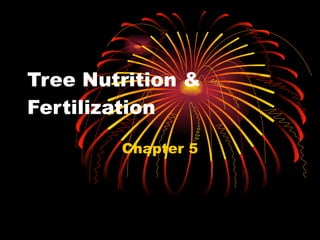Tree nutrition & fertilization isa chap 5
- 1. Tree Nutrition & Fertilization Chapter 5
- 2. Lorri B Grueber City of Lake Saint Louis LetˇŻs Grow Norwood Hills Country Club
- 3. A word from our sponsorsˇ
- 4. Questions before we get startedˇ
- 5. Test Day - Thursday April 10, 2008 Relax! Remember to think Chapters/Domains are not separated Trust your instincts
- 6. LetˇŻs get startedˇ Trees have needs, i.e. essential elements Urban landscapes may not provide Only a soil or foliar analysis can tell
- 7. Fertilizer is NOT necessarily the answer! Poor prior planning Lack of education Play detective before prescribing
- 8. I need fertilizer- now what? Complete fertilizer Fertilizer analysis Organic vs. Inorganic Slow-release vs. controlled- release Water-insoluble (WIN)
- 10. WhatˇŻs the difference? Inorganic dissolves quickly in H2O Available nutrients are released as inorganic ions (what plants need) Contributes more to leaching and run-off Organic fertilizers also release inorganic ions (what plants need) Break down from temperature
- 11. Slow-release vs Controlled release Contain essential elements in a form that delays initial availability OR extends availability over time. Less leaching Less probability of fertilizer burn
- 12. WhatˇŻs the difference? Slow-release: Less predictable rate Depends mainly on the activity of organisms in the soil (i.e. temp) Controlled-release: Release nutrients at a specific rate over specific time period
- 13. Water-insoluble Nitrogen (WIN) Defines slow-release fertilizer If at least 50% WIN, slow-release.
- 14. Fix these trees Park setting Subdivision built ~4 years ago Soccer fields built ~3 years ago
- 15. Essential elements There are 18 See Hopkins caf¨¦, managed by my cousin Mocl (C H O P K N S Ca Fe Mg B Mn Cu Zn Mo Cl).ˇ± Plus Co & Ni
- 16. Macronutrients N P K S Ca Mg
- 17. Questions
Editor's Notes
- CTC meets every other month @ various locations & is an advisory council to the state regarding urban forestryˇ next meeting is in May. The MCFC conference is in March (4-6) in St. Joseph and registration forms are available online @ www.mocommunitytrees.com. As students of this training class, you will be receiving special invitations to the May meeting- watch for it! We would love to have you attend.
- An essential element is a chemical element that is involved in the metabolism of the tree or necessary for the tree to complete its lifecycle. In natural or forest settings debris such as leaf litter, twigs and shed bark break down and return nutrients to the soil. In an urban setting typically these items are removed regularly in order to provide a more manicured setting. Soil amendments may be necessary. There is another test- foliar analysis-that may be more beneficial however; it is significantly more expensive than a soil analysis, and the baseline data available is not yet widespread.
- If, after soil analysis is completed fertilizer is deemed necessary, refer to the ANSI A300 standards available through ISA for detailed specifications including objectives of fertilizing, type, rate and timing as well as the method and location of application. The more information you can provide your customer, the better everyone becomes. Prescription without diagnosis is malpractice! Residents of the subdivision through the tree line wanted these trees fertilized. That is a soccer field in the foreground. The subdivision is approximately 4 years old.
- A complete fertilizer contains Nitrogen (N), Phosphorous (P) and Potassium (K). The fertilizer analysis provides the composition of the fertilizer in a percentage by weight format. Example above bag is 50 lbs. 5%N-10%P-5%K how many pounds of each are in this bag of fertilizer?
- WhatˇŻs the difference? Organic fertilizers tend to break down more slowly than inorganic fertilizers, are less prone to ˇ°burnˇ± the plants and do not leach as readily as inorganic. Organics can be natural or synthetic. Synthetic organics are Urea formaldehyde and IBDU. Natural organics are blood meal, bone meal and milorganite.
- Would your professional prescription include any type of fertilization applications?
- Micronutrients are those elements needed only in trace amounts.
















